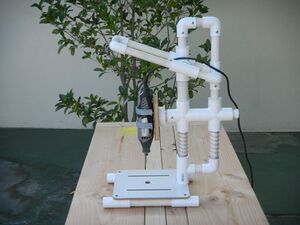Drill presses: Difference between revisions
From
No edit summary |
No edit summary |
||
| Line 1: | Line 1: | ||
{{Projects infobox | {{Projects infobox | ||
|image = PVC Drill press.jpg| | |image = PVC Drill press.jpg| | ||
| | |designers = [[User:Tim|Timothy Schmidt]] | ||
|date = 2013 | |date = 2013 | ||
|vitamins = | |vitamins = | ||
Revision as of 17:37, 18 September 2021
Project: Drill presses
| Designers: | Timothy Schmidt |
|---|---|
| Tools: | Wrenches |
| Parts: | Frames, Nuts, Bolts, Plates, End caps, Linear bearings, Motors |
| Techniques: | Shelf joints, Tri joints |
Introduction
A drill press (also known as a pedestal drill, pillar drill, or bench drill) is a style of drill that may be mounted on a stand or bolted to the floor or workbench. Portable models are made, some including a magnetic base. Major components include a base, column (or pillar), adjustable table, spindle, chuck, and drill head, usually driven by an electric motor. The head typically has a set of three handles radiating from a central hub that are turned to move the spindle and chuck vertically. A drill press is typically measured by its "swing", calculated as twice the distance from the center of the chuck to the closest edge of the column. Thus, a tool with 4" between chuck center and column edge is described as an 8" drill press.
Challenges
Approaches
Development targets
- Completion of the replimat linear bearing will allow for the construction of a linear motion system for the press mechanism
- Completion of the printable 1kW motor will allow for the power generating portions of the drill press to be copied
- Lost plastic casting, or direct metal printing will allow for a metalic version of the printable chuck.
